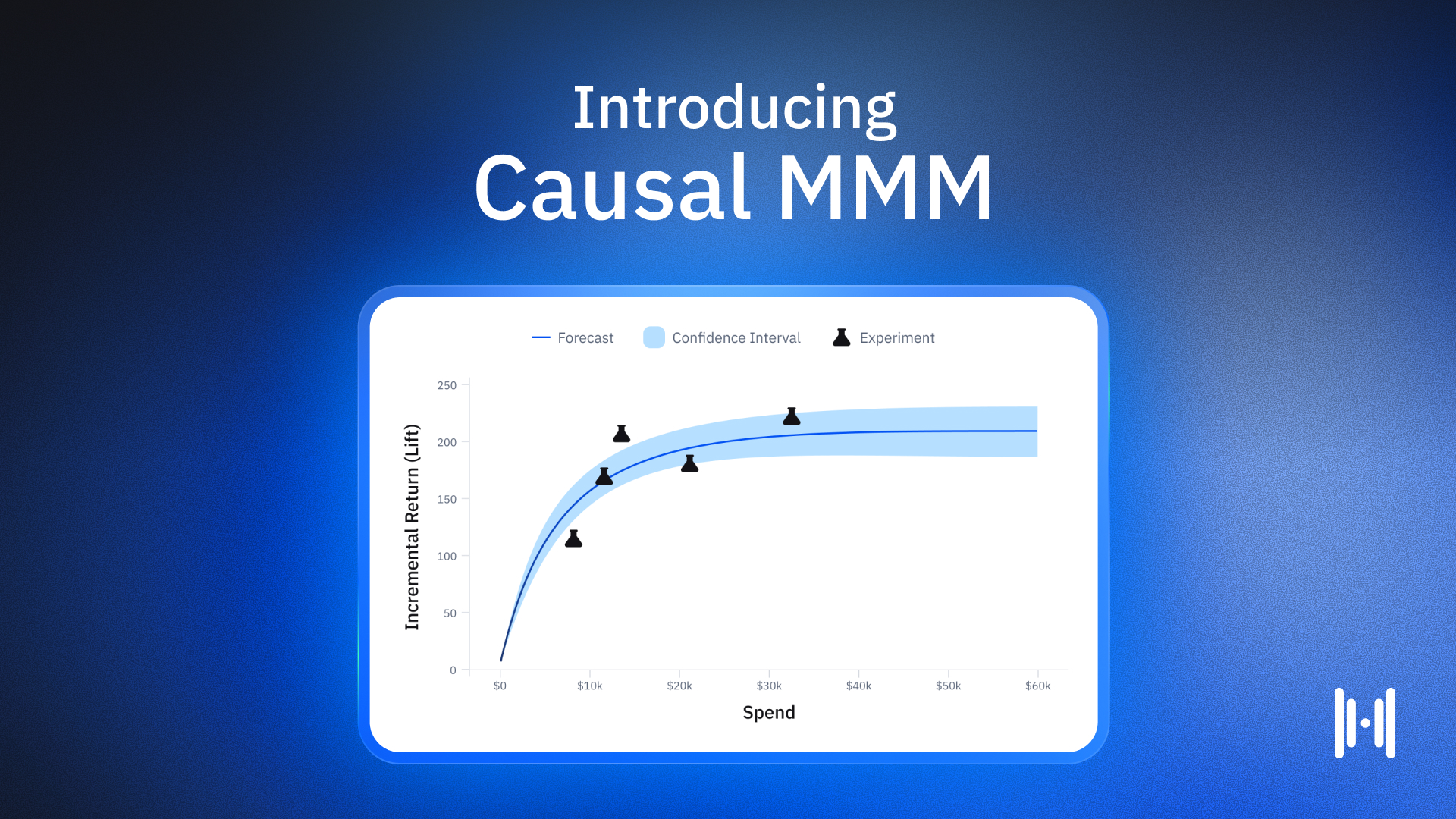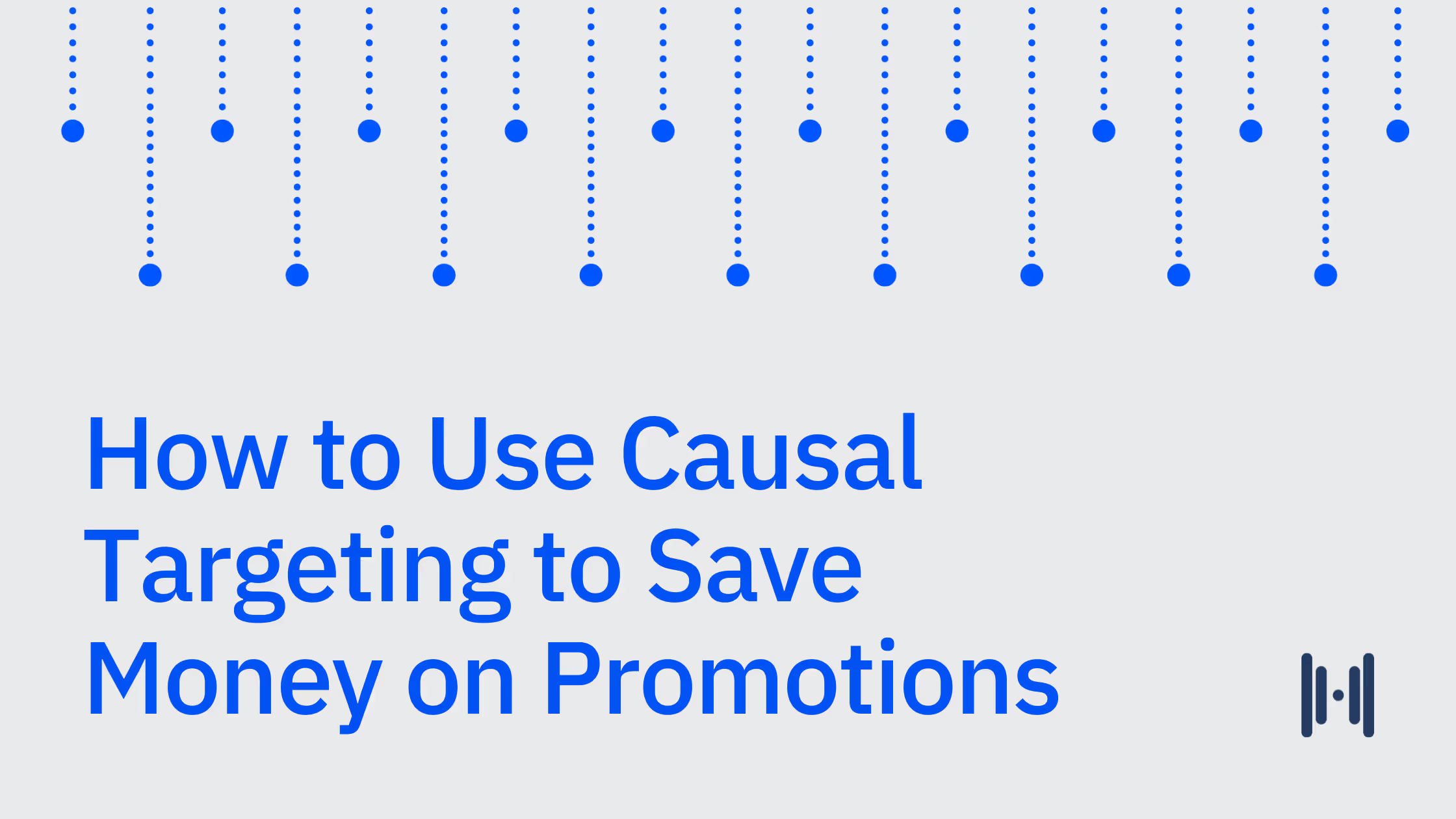
The terms “test-calibrated MMM” and “causal MMM” are often used interchangeably, but it’s crucial to clarify what sets them apart. Calibrating an MMM with experiments — “test-calibrating” — means using experiments as a supplement or adjustment. It doesn’t mean the model is fundamentally grounded in experimental results.
In contrast, a truly causal MMM is built on an experimental foundation, treating your test results as its core input and sharpening continuously as new experiments are run. Given that past industry language has blurred these lines, it’s worth clearly distinguishing between these two approaches and what they accomplish — so let’s dive in.
Overview of differences
The core difference: A test-calibrated MMM uses experiments as a supplemental adjustment, refining a model built mostly on observational data. In contrast, Haus’ Causal MMM is constructed on an experimental foundation, with tests driving the model’s structure and continuous updates.
The following table details these distinctions for greater clarity.
What is a test-calibrated MMM?
A test-calibrated MMM is a traditional mixed media model enhanced with limited controlled tests to refine attribution. This refinement improves accuracy but still relies on historical correlations rather than proving true causality.
Why is a test-calibrated MMM not enough?
The practical value of a test-calibrated MMM is limited for these reasons:
- A test-calibrated MMM relies on a static, historical framework — it looks backward, using old data as its structure, which means the model can’t easily adapt to new realities or changes in marketing strategy.
- The process behind these models is often opaque, making it challenging for teams to understand how decisions are made or reproduce results.
- Results tend to be murky and hard to translate into clear, actionable marketing moves, so teams might hesitate to act on the insights.
- Turnaround times further slow teams down, with analysis taking weeks or even longer, well after decisions need to be made.
Even with these limitations — lack of agility, poor visibility, unclear recommendations, and slow results — these models are still expensive investments. For this level of cost, marketers deserve tools that are more transparent, practical, and fit for the pace of modern decision-making.
What is a Causal MMM?
Causal MMM is inherently tuned by experiments (e.g., geo holdouts, randomized tests) to measure incrementality, which powers more accurate insights into ad spend effectiveness.
While test-calibrated MMM is often confused with Causal MMM, the two models are fundamentally different.
How does Causal MMM improve on a test-calibrated MMM?
Causal MMM turns the promise of marketing measurement into reality by grounding every insight in tests, not just observations. Here’s what sets it apart:
- Precision is built in. Because the model is built on experiments, it delivers more reliable answers — which helps teams know exactly which marketing channels drive sales.
- Clarity improves dramatically. Teams see direct causality between specific actions and specific sales, with no guesswork or murky correlations.
- Visibility is another major leap forward. Because every experiment and its impact is transparent within the model, you can clearly track why decisions are made.
- Causal MMM aligns with real business pace and needs, giving teams timely results that are easy to action on.
What does causality look like in practice?
Carefully designing experiments helps you understand a causal relationship. Just like randomized control trials help medical teams understand the true effectiveness of a drug, holdout tests help marketing teams pinpoint the true effectiveness of a marketing strategy.
Holdout tests involve pausing ads in a certain percentage of regions to establish a key counterfactual: “What would happen if we didn’t run these ads?”
For example, footwear brand Orthofeet turned off brand search in 30% of the US while continuing it in the remaining 70% of the country. Understanding the difference in lift between these two regions gave them useful insights into the effectiveness of brand search across their different sales channels.
Causal MMM is inherently tuned by the results of your holdout tests, providing you with a model built on a foundation of causal insights.
Test-calibrated MMM is based on a historical model
Test-calibrated MMM modifies the traditional model by adding experimental results to overlay causal insights, but its foundation is still correlation-based and historical. Ultimately, test-calibrated MMM refines, but does not replace, correlational underpinnings with controlled testing.
Causal MMM treats experimental data as ground truth
Causal MMM fundamentally changes how marketing impact is measured by making incrementality experiments the model's foundation, not just an optional upgrade. This approach ensures true precision — every channel’s contribution is evaluated through carefully controlled tests, so you see direct, reliable links between marketing spend and business outcomes.
Unlike test-calibrated MMM, which adjusts a static, historical framework with bits of experimental data, Causal MMM integrates experiments at every stage, offering complete visibility into what’s being tested and how the results inform broader strategy. Results move beyond vague correlations to reveal clear, actionable causality between specific marketing actions and specific outcomes.
The model continuously sharpens as new test results come in, making recommendations that evolve with your business. It also makes acting on data much simpler — budgeting decisions are grounded in real data, and the model can even recommend your next best experiment to maximize impact. Ultimately, Causal MMM empowers teams with faster, more transparent, and actionable insights, making every marketing dollar count.
An example: Causal MMM in action
A fast-growing DTC skincare brand struggled to pinpoint which channels truly impacted sales, relying on traditional MMM. Seeking more reliable guidance, they adopted Causal MMM and started embedding incrementality experiments directly into their marketing measurement. By routinely testing channels such as paid social, influencer, and direct mail, they gathered direct evidence on which spend moved the needle.
Causal MMM’s clarity quickly paid off: Results showed that prior budget poured into paid social platforms was delivering limited incremental sales uplift, while influencer partnerships — previously underestimated — demonstrated clear, causal impact.
With full transparency and visibility into test results, the team confidently redistributed their budget, reducing inefficient paid social spend and scaling up influencer investment.
Actions and budget moves became obvious. Causal MMM’s continuous test-driven updates enabled the team to act faster and, with ongoing recommendations for next experiments, ensured every new campaign was grounded in measurable, real-world impact.
Implementing a causality-driven MMM is complex
The complexity of experimentation and analysis is of course a strength… but setting everything up requires real expertise and attention. In general, we don’t advise teams to build their own in-house media mix model.
Testing partners like Haus provide that expertise and guidance so clients can simply show up with their questions and then get the answers soon after. For more on how Haus’ Causal MMM provides a fully transparent, experiment-driven approach, read our comprehensive overview.
.png)
.png)
.png)
.png)
.avif)


.png)
.png)
.png)
.png)
.png)

.avif)
.png)
.png)
.png)
.png)
.png)
.png)
.png)
.png)
.png)
.webp)
.webp)
.webp)
.webp)

.webp)

.webp)
.webp)
.webp)
.webp)
.webp)
.webp)
.webp)
.webp)
.webp)
.webp)

.webp)
.webp)
.webp)
.webp)
.webp)

.webp)


.avif)
.avif)



.avif)
.avif)
.avif)


.avif)
.avif)
.avif)
.avif)
.avif)
.avif)




.png)
.avif)
.png)
.avif)



















